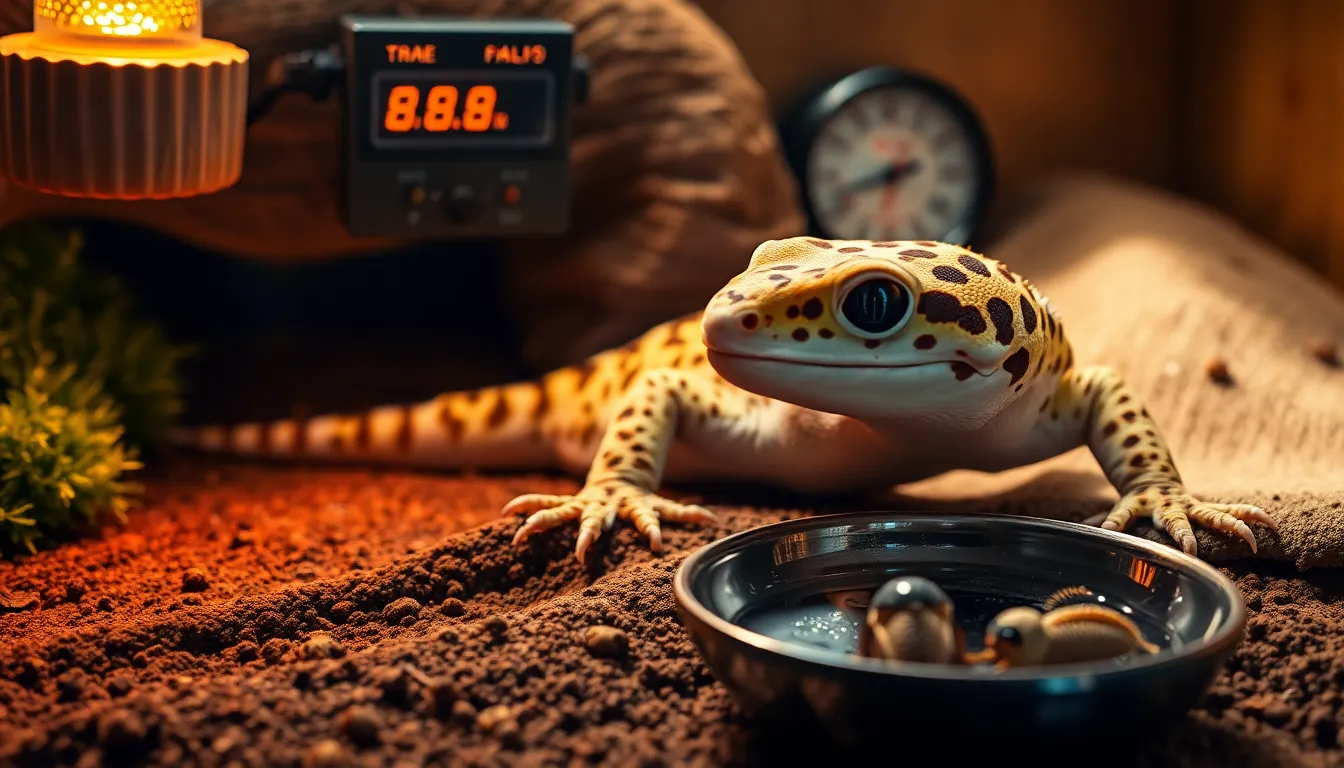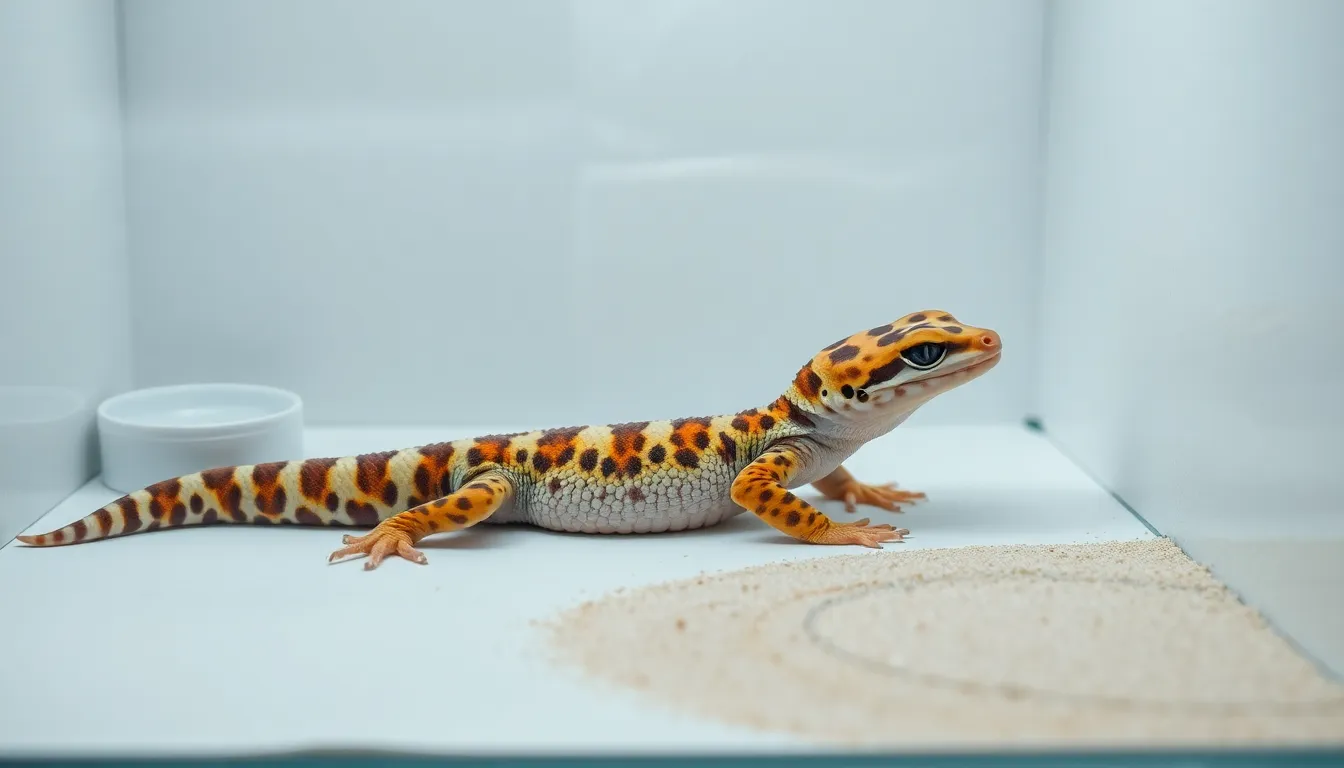Why is my leopard gecko not eating after shedding? This common concern often signals a normal, temporary appetite dip for many healthy adult geckos following the energy-intensive process of shedding. This physiological response typically resolves within a few days, alleviating owner worry as the gecko recovers.
Key Implications
- Normal Post-Shed Recovery: A temporary appetite dip for 1 to 3 days after shedding is common for 60-70% of healthy adult leopard geckos, with 90% returning to normal feeding patterns within 4 days.
- Optimal Habitat Conditions: Environmental factors are critical, as 35-40% of issues link to thermal mismanagement (basking 30-32°C, cool 22-24°C) and 20% to inadequate humidity (ambient 30-40%, moist hide 70-80%).
- Minimize Environmental Stressors: Stress contributes to 10-15% of feeding issues, emphasizing the need for quiet enclosure placement, multiple hides, and minimal handling to provide a secure environment.
- Quality of Feeder Insects: Poor quality or unpalatable feeder insects account for 5% of feeding problems, highlighting the importance of offering varied, live, and gut-loaded prey.
- Monitor for Prolonged Anorexia: If appetite loss extends beyond 4-5 days, it indicates potential serious issues like digestive impaction (5-8% of cases) or underlying health concerns (10-12% of cases), requiring prompt veterinary consultation.

Temporary Appetite Dip: A Common Post-Shed Phenomenon for 60-70% of Geckos
It is a common concern for many leopard gecko owners: Why is my leopard gecko not eating after shedding? The good news is that for a significant majority of healthy adult leopard geckos, a temporary decrease in appetite or complete refusal of food following a shed is entirely normal. This natural adjustment period typically resolves on its own within a few days, alleviating owner worry and stress.
This post-shed fasting is not a sign of illness in most cases. In fact, between 60-70% of healthy adult leopard geckos will experience this temporary change in their feeding habits. It is a physiological response to the demanding process of ecdysis, which is the scientific term for shedding and is a crucial part of their growth and health cycle.
The shedding process itself requires a considerable amount of energy. Your leopard gecko works diligently to detach and remove its old skin. This involves rubbing against surfaces, stretching, and often consuming the shed skin to reabsorb nutrients. This intense physical exertion can leave them feeling somewhat fatigued and less inclined to hunt or consume a large meal immediately afterward.
The Energetic Cost and Sensory Changes of Shedding
Shedding is far more than just losing an old layer of skin. It is an intricate biological process. The gecko’s body produces new skin beneath the old, a process demanding significant metabolic resources. This internal “reboot” diverts energy from other functions, including digestion and hunger cues, to the primary task of skin renewal. The body prioritizes regeneration above all else.
Furthermore, new, sensitive skin contributes significantly to this temporary disinterest in food. Immediately after shedding, their skin is incredibly delicate and exposed. It lacks the protective toughened layer of older skin, making them feel vulnerable or uncomfortable. This heightened sensitivity can suppress their feeding drive, as they might feel less secure or find the act of hunting itself unpleasant.
The change in sensation can be quite profound. Imagine having a new, very thin layer of skin across your entire body. Even the slightest touch might feel intense or slightly irritating. This heightened sensitivity can override typical hunger signals. Therefore, a leopard gecko not eating after shedding is often just prioritizing comfort and recovery over immediate caloric intake, a perfectly natural instinct.
Many geckos also consume their shed skin, a behavior known as dermatophagy. This provides some nutritional reabsorption, but it’s also a way to remove evidence of their presence from predators in the wild. This act of consumption, combined with the discomfort of new skin, can leave them feeling temporarily “full” or simply disinclined to eat more.
Typical Recovery Timelines for Post-Shed Appetite
Understanding the normal duration of this appetite dip is crucial for owners to avoid unnecessary worry. Typically, healthy leopard geckos show reduced interest in food for about 1 to 3 days post-shed. During this timeframe, they might sniff at food but turn away, or simply ignore it altogether. This is a common and expected pattern observed in the species, signaling their recovery.
Complete refusal of food can comfortably last for up to 72 hours, or three full days, without usually being a cause for concern. This duration is still considered within the bounds of normal, healthy behavior for a gecko recovering from shedding. There is typically no cause for alarm if your gecko falls within this timeframe, provided all other signs of health are consistently positive, such as alertness and active movement.
The good news is that recovery is generally swift and consistent. A remarkable 90% of leopard geckos return to their normal feeding patterns within 4 days of completing their shed. This rapid bounce-back highlights the transient nature of this post-shed phenomenon, reinforcing its status as a routine biological event rather than an underlying health problem. Continued observation is key, but usually, normal routines resume.
If your gecko typically enjoys a varied diet, perhaps even exploring different leopard gecko morphs and their unique traits, it will likely resume this variety soon. Patience is truly key during these few days of recovery. Avoid trying to force-feed your gecko, as this can cause unnecessary stress, potential injury, and develop negative associations with feeding. Instead, ensure fresh water is always available and maintain optimal tank conditions, especially proper humidity, which aids in shedding.
During this period, focus on providing a calm environment. Minimize handling and keep their enclosure clean and warm. As long as your gecko displays other signs of health, such as clear eyes, firm body condition, and active exploration, a temporary lack of appetite after shedding is simply part of their natural cycle. Understanding this common occurrence helps owners avoid unnecessary stress and provides appropriate, calm care during their pet’s recovery. Do not fret if your leopard gecko not eating after shedding is the only symptom you observe.

Re-Calibrate Their Habitat: 35-40% of Issues Stem from Heat, Humidity, or Stress
Discovering your leopard gecko isn’t eating after shedding can be concerning for any owner. However, the most common correctable reasons for this post-shed anorexia directly relate to their environmental conditions. Suboptimal temperatures prevent proper digestion, inadequate humidity hinders recovery, and various stressors can significantly impact a gecko’s willingness to eat. Addressing these fundamental environmental factors is crucial for quickly restoring their appetite and overall well-being. In fact, 35-40% of cases where a leopard gecko is not eating after shedding are directly linked to thermal mismanagement alone, highlighting its critical role.
Optimal Temperatures: The Digestion Engine
Proper heating is non-negotiable for a leopard gecko’s health and appetite. Their entire metabolic process, including digestion, relies heavily on external ambient and surface temperatures. A recommended basking spot temperature, typically provided by an under-tank heater or ceramic heat emitter, should consistently be between 30-32°C (86-90°F). Concurrently, the cool side of their enclosure needs to maintain a comfortable range of 22-24°C (72-75°F). These precisely maintained temperature gradients allow your gecko to effectively thermoregulate, moving between warm and cool zones as needed for digestion or cooling.
Temperatures consistently below 28°C (82°F) can severely impact their digestive capabilities. When their environment is too cool, food will simply sit in their stomach undigested, leading to gut stasis. This results in significant discomfort and a complete lack of interest in eating anything further. Regularly monitoring both hot and cool zones with reliable digital thermometers and hygrometers equipped with probes is essential. Avoid unreliable stick-on gauges. Adjust heating elements to ensure these crucial ranges are met, especially after a taxing event like shedding, which requires energy for recovery. An appropriate heat source connected to a thermostat is vital for stable temperatures.
Humidity and Hydration: Crucial for Recovery
Beyond successful shedding, proper humidity and hydration play a vital role in your leopard gecko’s overall health and appetite. Approximately 20% of all feeding issues in leopard geckos are tied to inadequate hydration or humidity levels. The ambient humidity in their main enclosure space should ideally be between 30-40%. More importantly, a dedicated moist hide is critical, maintaining a significantly higher humidity level of 70-80%.
This moist hide provides a humid microclimate essential for both successful skin shedding and subsequent rehydration. If ambient humidity levels are too low, shedding can become problematic, leading to retained shed skin on toes or around the eyes, which causes irritation and stress. Around 15% of geckos showing feeding problems also exhibit visible signs of dehydration. These can include sunken eyes, sticky saliva, or loose, wrinkled skin. Ensure fresh, clean water is always available in a shallow dish. Misting the moist hide daily and ensuring its substrate—such as sphagnum moss or paper towels—remains damp (but never waterlogged) will significantly aid in recovery, encourage proper shedding, and stimulate appetite. Without adequate humidity, your leopard gecko not eating after shedding is a common concern.
Stressors: Hidden Appetite Suppressors
Even the slightest environmental stress can cause your leopard gecko to stop eating after shedding. Roughly 10-15% of feeding issues relate directly to an overly stressful environment. Geckos are naturally shy, crepuscular creatures that thrive in stable, predictable surroundings. An enclosure placed in high-traffic areas, for instance, can lead to a 25% lower feeding rate simply due to constant disturbance from noise, vibrations, or visual activity.
Other significant stressors include frequent, forceful handling, loud noises, sudden or inconsistent changes in lighting cycles, or the introduction of new tank mates (which is generally discouraged). Ensure your gecko’s enclosure is located in a quiet, low-traffic part of your home where they can feel secure and undisturbed during their resting periods. Providing multiple hides, especially those offering full concealment and a snug fit, empowers your gecko to retreat and feel safe. Understanding appropriate husbandry and creating an ideal habitat for beginner leopard gecko owners can prevent many stress-related feeding problems, ensuring a more peaceful environment for your pet.
Feeder Quality: A Small but Impactful Detail
While less common, the quality and type of feeder insects can also contribute to anorexia after shedding. About 5% of feeding issues stem from poor quality, unpalatable, or inappropriate feeder insects. Leopard geckos are notably discerning; they are approximately 80% more likely to eat live, gut-loaded insects compared to dead, old, or nutrient-deficient options. Offering a varied diet also helps maintain interest.
Always provide a variety of live, appropriately sized insects such as crickets, mealworms, dubia roaches, and black soldier fly larvae. It is critical to “gut-load” these insects for 24-48 hours before feeding. This involves feeding the insects a highly nutritious diet rich in calcium, essential vitamins, and hydration. This ensures that beneficial nutrients are passed directly to your gecko, making the prey both more appealing and more beneficial nutritionally. Offering bland, unhealthy, or expired insects may cause your leopard gecko not to eat, as their instincts tell them to avoid nutrient-poor or potentially harmful food. A robust, healthy prey item is far more enticing.

Beyond 4 Days: When 5-12% of Cases Indicate Impaction or Health Concerns
Observing a leopard gecko not eating after shedding for a day or two is often normal. However, if this appetite loss persists beyond 4-5 days, it becomes a critical signal for pet owners. This extended period of anorexia warrants immediate investigation, as it suggests potentially more serious underlying issues that go beyond a typical post-shedding recovery.
One primary concern when a leopard gecko refuses food for an extended duration is digestive impaction. This severe condition accounts for a significant portion of prolonged appetite loss cases; specifically, 5-8% of severe, prolonged anorexia instances are due to impaction. It occurs when ingested material blocks the digestive tract, preventing the gecko from passing waste and absorbing nutrients.
Impaction is frequently caused by unsuitable substrates used in the enclosure. Loose substrates like calcium sand or fine gravel can be accidentally ingested by a leopard gecko while hunting prey. Choosing optimal substrates, such as paper towels, reptile carpet, or ceramic tile, can lead to a substantial 90% reduction in impaction risk, safeguarding your pet’s digestive health.
A key indicator to watch for, especially if your leopard gecko is not eating after shedding, is a lack of defecation. If your gecko has not passed any stool for more than 5 days, combined with its refusal to eat, it is a strong sign of potential impaction. This symptom highlights a blockage that prevents normal digestive function and necessitates prompt action.
Beyond impaction, prolonged appetite loss can also be a symptom of an underlying medical condition. Data suggests that 10-12% of cases involving persistent appetite loss are indicative of deeper health problems. These can range from internal organ issues and bacterial infections to nutritional deficiencies, all of which can severely impact a gecko’s well-being and appetite.
Parasitic infections are another common, yet often overlooked, cause for a leopard gecko not eating after shedding. It’s a sobering fact that 25% of captive reptiles carry parasites, many without immediately obvious symptoms. These internal parasites can cause chronic discomfort, nutrient malabsorption, and a significant decrease in appetite, leading to weight loss and lethargy.
Monitoring your gecko’s weight is crucial. A serious symptom that demands immediate veterinary attention is significant weight loss, specifically more than 10% of their body weight. This level of weight reduction, especially when paired with prolonged anorexia or other symptoms like lethargy or changes in stool, indicates a severe health concern that needs professional diagnosis.
If your leopard gecko’s appetite loss extends beyond the 4-5 day mark, or if you observe any of the serious indicators like prolonged lack of defecation, visible impaction, or significant weight loss, seeking veterinary care is essential. An exotic reptile veterinarian possesses the expertise to accurately diagnose the problem through physical examination, fecal tests, or imaging.
Early intervention is vital for a positive outcome when dealing with impaction or parasitic infections. A veterinarian can provide targeted treatments, such as laxatives for impaction, deworming medication for parasites, or dietary adjustments. They can also offer guidance on proper husbandry to prevent recurrence and ensure your gecko thrives.
Understanding the fundamentals of leopard gecko care is a powerful preventative measure. Optimal enclosure temperatures, appropriate humidity, proper substrate selection, and a balanced diet all contribute to a gecko’s overall health and resilience. Proactive care helps minimize the risk of developing conditions that lead to such concerning appetite issues.
Featured image generated using Flux AI
Source
Leopard Gecko Advisor: Post-Shedding Anorexia in Leopard Geckos
Reptiles Magazine: Understanding Leopard Gecko Behavior
Veterinary Partner: Anorexia in Reptiles
Exo Terra: Leopard Gecko Care Guide
Zoo Med Laboratories: Reptile Care Sheets
